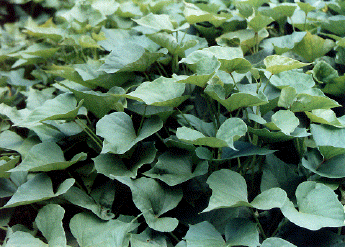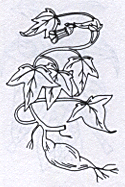Canoe Plants of Ancient Hawai`i Home - Intro - Contents - Bibliography - Links - Credits `Ape - `Awa -`Awapuhi -Hau -Ipu -Kalo -Kamani -Ki -Ko -Kou -Kukui -Mai`a Milo -Niu -Noni -`Ohe -`Ohi`a `Ai -`Olena -Olona -Pia -`Uala -Uhi -`Ulu -Wauke |
Canoe Plants of Ancient Hawai`i Home - Intro - Contents - Bibliography - Links - Credits `Ape - `Awa -`Awapuhi -Hau -Ipu -Kalo -Kamani -Ki -Ko -Kou -Kukui -Mai`a Milo -Niu -Noni -`Ohe -`Ohi`a `Ai -`Olena -Olona -Pia -`Uala -Uhi -`Ulu -Wauke |
 `Uala - here's a plant that grows easily, is a valuable high-yield food and tastes delicious. This member of the morning glory family is thought to be of tropical South American origin, and was brought to Hawai`i by early Polynesian settlers as an important staple in their diet. There are many varieties of Ipomoea batatas, most maturing in 3-7 months from time of planting.
`Uala - here's a plant that grows easily, is a valuable high-yield food and tastes delicious. This member of the morning glory family is thought to be of tropical South American origin, and was brought to Hawai`i by early Polynesian settlers as an important staple in their diet. There are many varieties of Ipomoea batatas, most maturing in 3-7 months from time of planting. The people of ancient Hawai`i grew about 200 varieties of `uala. Now there are only a few. In old Hawai`i, the cultivation of `uala was one of the few agricultural ventures shared by both men and women. `Uala is planted in mounds, ridges or flat ground, from sea level to 5,000 feet elevation. These plants will grow in areas of poor soil with limited rainfall, but thrive in loamy soil, producing larger tubers where the soil is loose and more porous. They are a drought-resistant vegetable, enjoying plenty of sunshine. One hundred well-tended plants produce about 150 pounds of tubers.
The people of ancient Hawai`i grew about 200 varieties of `uala. Now there are only a few. In old Hawai`i, the cultivation of `uala was one of the few agricultural ventures shared by both men and women. `Uala is planted in mounds, ridges or flat ground, from sea level to 5,000 feet elevation. These plants will grow in areas of poor soil with limited rainfall, but thrive in loamy soil, producing larger tubers where the soil is loose and more porous. They are a drought-resistant vegetable, enjoying plenty of sunshine. One hundred well-tended plants produce about 150 pounds of tubers.
This sweet potato is a vigorous plant that spreads its dark green heart-shaped or five-lobed leaves closely to the ground. The large tuberous roots range in color from purple to white or orange. The flowers are pinky-lavender and tubular, resembling small morning glories.
The season of planting varies with the variety and locale. In a dry locality, after the early winter rains begin is considered the best planting time. In wet areas, it is best to plant after a wintertime of rain is passing. A slightly acid soil is preferred.
Propagation is from stem cuttings or slips, not from the tubers. the 6-9 inch slips are planted about a foot apart, preferably in mounds, pu`e, or ridges, allowing the vines to trail off outside the beds. It is a good idea to plant `uala near the periphery of a garden, as the plants tend to take over the area in which they grow, and to wander on and on. The vines make a lovely ground cover in any event.
In planting, the older vines are used, with the cuttings being vine ends broken off from 10-20 inches from the tip. Gather these in the evening, not in the heat of the day. Pluck all leaves off except for three or four at the end, being careful to leave the leaf bud at the tip. Planting can be the next day, or even several days later, if the slips are kept moist, such as in a bucket of water. Root buds may begin to appear during this time.
| He `uala ka `ai ho`ola koke i ka wi. The sweet potato is the food that ends famine quickly. The sweet potato is a plant that matures in a few months. |
The leaves may be steamed, boiled or baked. The tuber is a carbohydrate. A good source of Vitamin A, calcium and phosphorus, most of the nutrients are near the skin. Therefore, it is nutritionally best to steam or bake the potatoes in their scrubbed skins in an oven or in an imu, rather than to boil them. If mixed with water, the cooked, skinned and mashed `uala makes a sweet potato poi. The tubers and greens are also used as food for livestock, especially pigs.
In addition to providing food, some varieties in ancient days were used medicinally. `Uala was used as a tonic during pregnancy and to induce lactation. Other varieties were said to cure asthma. `Uala was also used as a laxative, and could be prepared as a gargle for sore throat and to reduce phlegm. Raw `uala mixed with ti stem was used when it was necessary to induce vomiting. One variety was used as fish bait, while old vines and leaves of `uala were placed beneath floor mats as padding.
When harvesting the `uala, dig carefully so as not to injure the potato. The tubers should be dried and cured in a protected place for a week after they are dug up. During this process, the carbohydrates turn towards sugar, sweetening the flavor of the potato.
Kamapua`a is said to be the god of the sweet potato. This god has a pig-like snout, making it possible for him to root up the tubers. Happy growing, harvesting and eating of the `uala to you, even though unlike Kamapua`a, you use a trowel or shovel.
| Canoe Plants of Ancient Hawai`i Home Intro - Contents - Bibliography - Links - Credits `Ape -`Awa -`Awapuhi -Hau -Ipu -Kalo -Kamani -Ki -Ko -Kou -Kukui -Mai`a |